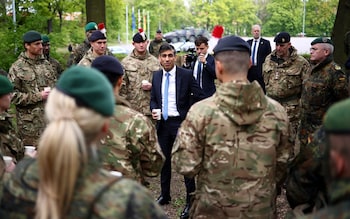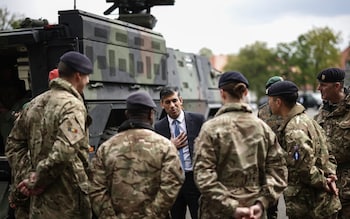Joe Biden will sign into law a military aid package worth $95 billion for America’s allies after months of political in-fighting over Washington’s involvement in the war in Ukraine.
The spending bill has earmarked $61 billion to support Kyiv’s resistance and is seen as vital in turning the tide of war following a number of setbacks in its battle against Russian occupation.
In the months that the US support was held up in Congress by Republicans loyal to Donald Trump, shortages of artillery ammunition on the front lines resulted in Russian gains and Moscow stepped up its long-range bombardment of Ukrainian cities as Kyiv ran low on air-defence interceptor missiles.
Both US and Nato officials directly attributed Russia’s successes on the battlefield to the delays, with Jens Stoltenberg, the military alliance’s secretary-general, unusually being forthright in his criticism of the Republicans for blocking aid.
While Washington’s tranche of support is not expected to help Ukraine win the war, it is believed to be enough to stabilise the situation in at least three critical areas.
Air defence
Volodymyr Zelensky last week called an emergency meeting of the Nato-Ukraine Council to discuss the devastation caused by Russia’s missile and drone attacks on energy infrastructure.
He told the alliance’s defence ministers that his country had been hit by almost 1,200 missiles, more than 1,500 drones and 8,500 guided bombs this year alone.
The dome of protection from Ukraine’s complex web of Western and Soviet-era surface-to-air defence systems was starting to show signs of leaks.
Mr Zelensky last week revealed the Trypilska coal-powered thermal power plant, about 25 miles south of Kyiv, was destroyed because Kyiv had run out of air defence missiles.
The main system used to defend Ukrainian cities against Russia’s arsenal of hypersonic and ballistic missiles in the American-made Patriot system.
Germany has donated three batteries to Ukraine, but the US is still the principal provider of Pac-2 missiles fired from Patriot launchers.
America has not set out whether it will donate more missiles, but part of the military aid is expected to be used to convince European allies to hand over their Pac-2s to speed up delivery.
Some $7.3 billion is allocated to cover the costs of US operations in Europe, while another $13 billion to replenish US stockpiles.
Matthew Savill, Rusi’s military sciences director, said: “This could free up other materiel for donation.”
Ukraine is calling for up to seven Patriot batteries to help it protect its major cities. In recent weeks, Kyiv’s European allies – Germany aside – have failed to make any significant pledges towards the goal, leaving the US to meet its needs.
Artillery and Himars
“We would expect a priority to be artillery,” Mr Savill said of the US aid package
Kyiv has 15 different types of 155mm howitzers that have been donated by its Western allies.
The guns have been working overtime in a war that has largely been dominated by artillery fire.
This has resulted in shortages of the 155mm shells and the barrels, which eventually succumb to usage, amongst Ukraine’s artillery units.
The US has sent at least two million shells to Ukraine since February 2022, as well as M777 howitzers that strike targets at a range of almost 14 miles.
But shortages have led to Russia achieving what experts have described as a five-to-one advantage in artillery fires.
In some areas of the battlefield, this number could increase massively in Moscow’s favour.
“While procurement of new materiel might create a lag, the Pentagon has already said that some items readied for donation but awaiting approval have been positioned so as to minimise delivery time, almost certainly including 155mm shells,” Mr Savill said.
“It’s unlikely this will create immediate parity with the Russian volume of fire, but it will help close the gap.”
Himars, the multiple launch rocket systems donated by the US, are likely to become a particular focus if Kyiv is going to regain the initiative on the battlefield.
Ukrainian forces recently lost one of the systems, the first to be destroyed, when a Russian missile hit it moving in a field near the Donetsk region town of Pokrovsk.
There is no suggestion the entire system will be replaced by Washington, but more Gmlrs rockets are almost guaranteed.
The rocket launchers have played a vital role in Ukraine’s deep strikes used to interrupt Russian logistics. They are often used to hit munitions depots or air defence systems.
Without this capability, Ukraine will have virtually no chance of recapturing land if it is to mount a counter-offensive against Russian-held territories in the future.
Atacms
For the first time, Washington has signalled it is prepared to donate newer versions of its long-range ballistic missile.
Ukraine received older versions, which can hit targets at a range of around 110 miles with cluster munitions, last year.
But Kyiv is now set to be handed newer Atacms capable of strikes as far away as 186 miles.
Ukraine’s air force has been using British and French Storm Shadow air-launched cruise missiles to fire deep into occupied Crimea and Russian bases in Donetsk and Luhansk.
The addition of Atacms, which are fired by Himars from the ground, will add another asset to Ukraine’s deep fire capabilities, and protect its fleet of Soviet-era jets used to fire Storm Shadow.
Will US aid make a difference?
There is no doubt that the massive aid package from Washington is going to make a difference on the battlefield, even if it enables Ukrainian soldiers to stop making life-or-death decisions on when to fire artillery shells.
But there is no expectation that it will come as a silver bullet to help Kyiv finally win the war against Russia.
“The main point is that this funding can probably only help stabilise the Ukrainian position for this year and begin preparations for operations in 2025,” Mr Savill said.
“The boost to morale and more ammunition to strengthen their defences are necessary pre-conditions for the hard work to begin reconstituting Ukrainian combat forces and – critically – collective training to build a force that stands a chance of making progress next year.
“Predictability of funding through 2024 and into 2025 will help the Ukrainians plan the defence this year, especially if European supplies of ammunition also come through, but further planning and funds will be required for 2025, and we have a US election between now and then.”
Disclaimer: The copyright of this article belongs to the original author. Reposting this article is solely for the purpose of information dissemination and does not constitute any investment advice. If there is any infringement, please contact us immediately. We will make corrections or deletions as necessary. Thank you.



